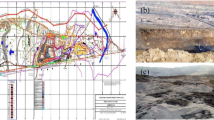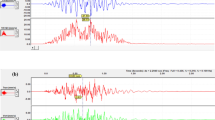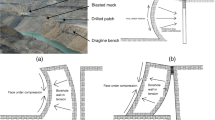Abstract
The presence of structural inhomogeneity in a rock mass in the form of joints, fractures, bedding planes is a very common phenomenon. These discontinuities have a great influence on rock fragmentation as explosive energy is significantly affected by it. The extent of these discontinuities also has a great influence such as the thickness of the joint interfaces which varies from very tight joints to open ones. The amount of energy (or stress) generated by explosives, transmitted through the joints and energy can be passed over the interface resulting in poor fragmentation. The paper is based on the challenges faced during the study at Sangmania and Birhauli limestone mines to achieve the desired fragmentation as the rock formation of the area is dominated by joints and layered bedding. Experimental practices viz. drilling of holes, drill pattern designs, delay intervals and charging of explosives (with or without deck) have been performed to achieve desired fragmentation. Fifty blasts have been conducted at different quarries of Sagmania and Birhauli mines to determine the effect of both joint spacing and orientation on rock fragmentation. Two hundred thirty-six ground vibrations data have been recorded and compared for different prediction equations for better control on ground vibration. The in-hole velocities of detonation of explosives were monitored and optimal deck length and deck types were optimized to improve the fragmentation. The in-situ block size and blasted block size were determined to evaluate the efficiency of blasting.


















Similar content being viewed by others
References
Abu Bakar MZ, Tariq SM, Hayat MB, Zahoor MK, Khan MU (2013) Influence of geological discontinuities upon fragmentation by blasting. Pak J Sci 65(3):414–419
Aldas GGU, Bilgin HA (2004) Effect of some rock mass properties on blasting-induced ground vibration wave characteristics. CIM Bull 97(1079):52–59
Ambraseys NR, Hendron AJ (1968) Rocks mechanics in engineering practices. In: Stagg KG, Zienkiewics OC (eds.), Wiley, London, pp 203–207
Anon (1987) Explosive and rock blasting. Atlas Power Company, Dallas, p 662
Aziznejad S, Esmaeili K (2015) Effects of Joint Intensity on Rock Fragmentation by Impact. In: Proceedings of 11th international symposium on rock fragmentation by blasting, Sydney, NSW, August 24–26, pp 377–384
Azmi RJ (1998) Discovery of Lower Cambrian small shelly fossils and brachiopods from the Lower Vindhyan of Son Valley, Central India. J Geol Soc India 52:381–389
Bhandari S (1996) Changes in fragmentation processes with blasting conditions. In: Mohanty B (ed.), Rock fragmentation by blasting—Fragblast 5, Montreal, Canada, pp 301–312
Burkle WC (1979) Geology and its effect on blasting. In: Proceedings of the 5th conference on explosives and blasting techniques, SEE, pp 105–120
Duvall WI, Fogleson D (1962) Review of criteria for estimating damage to residences from blasting vibration, USBM – I 5968
Duvall WI, Petkof B (1959) Spherical propagation of Explosion of generated strain pulses in rocks, vol 5783. USBM, RI, pp 21–22
Fordyce DL, Fourney WL, Dick RD, Wang XJ (1993) Effect of joints on stress wave transmission. In: Rossmanith HP (ed.), Rock fragmentation by blasting—Fragblast 4, Vienna, Austria: pp 211–220
Fourney WL, Dick RD, Wang XJ, Weaver TA (1997) Effects of weak layers on particle velocity measurements. Rock Mech Rock Eng 30(I):118
Holmberg R (1993) Recent developments to control rock damage. In: Rossmanith HP (ed.), Proceedings of the 4th international conference on rock fragmentation by blasting, Vienna, Austria, Rotterdam: Balkema, July 5–8, pp 197–198
Hustrulid W (1999) Blasting principles for open-pit mining, vol 1. Balkema Pub, A. A, p 382
Indian Standard (1973) Criteria for safety and design of structures subjected to underground blast. ISI Bull., IS-6922.
Langfors U, Kihlstrom B (1978) The modern techniques of rock blasting. Wiley, New York, p 438
Lewandowski TH, Luan Mai VK, Danell RE (1996) Influence of discontinuities on presplitting effectiveness. In: Mohanty B (ed.), Rock fragmentation by blasting—Fragblast 5, Montreal, Canada: pp 217–232
Noy MJ (2012) Automated rock fragmentation measurement with close-range digital photography. In: Measurement and analysis of blast fragmentation workshop, held at Fragblast 10—10th international symposium on Rock Fragmentation by Blasting, CRC Press, Balkema, pp 13–21
Onedera M, Thurley M, Catalan A (2015) Measuring blast fragmentation at Esperanza mine using high-resolution 3D laser scanning. Trans Inst Min Metall Min Technol 124(1):A34–A36
Persson PA, Holmberg R, Lee J (1994) Rock blasting and explosives engineering. CRC Press, Boca Raton, pp 259–264
Richter CF (1958) Elementary seismology. SanFrancisco, W. H. Freeman and Co, p 768
Rockwell EH (1927) Vibration caused by quarry blasting and their effect on structures. The Explosives Engineer, March, pp. 93–96 and April, pp. 143–145
Rustan A, Yang ZG, (1983) The influence from a primary structure on fragmentation. In: 1st international symposium on rock fragmentation by blasting. v. 2, Lulea, Sweden, pp 581–604
Sauvage AC (2012) Applied method integrating rock mass in blast design. In: 10th international symposium on rock fragmentation by blasting, FRAGBLAST 10, CRC Press, Balkema, pp 77–83
Sen G (1992) Rock property influence on fragmentation at rock blasting—a literature review. Technical Report, Division of Mining and Rock Excavation, ISSN 0349 - 3571, 1992:16T, Lulea University of Technology.
Singh PK (2002) Blast vibration damage to underground coal mines from adjacent open-pit blasting. Int J Rock Mech Min Sci 39(8):959–973
Singh DP, Sastry VR (1987) Role of weakness planes in bench blasting—a critical study. In: 2nd international symposium on rock fragmentation by blasting, Keystone, Colorado, U.S.A., August 23–26, pp 135–146
Singh PK, Roy MP, Joshi A, Joshi VP (2009) Controlled blasting (pre-splitting) at an open-pit mine in India. In: Proceeding of 9th international symposium on rock fragmentation by blasting, Granada, Spain, pp 481–489
Singh PK, Roy MP, Paswan RK (2014) Controlled blasting for long term stability of pit-walls. Int J Rock Mech Min Sci 70:388–399
Singh PK, Roy MP, Paswan RK, Dubey RK, Drebenstedt C (2015) Blast vibration effects in an underground mine caused by open-pit mining. Int J Rock Mech Min Sci 80:79–88
Tariq SM, Worsey PN (1996) An investigation into the effect of varying joint aperture and nature of the surface on pre-splitting. In: Proceedings, 12th symposium on explosives and blasting research, pp 186–195
Valdivia C, Vega M, Scherpenisse CR, Adamson WR (2003) Vibration simulation method to control stability in the Northeast corner of Escondida Mine. Int J Rock Fragm Blast FRAGBLAST 7(2):63–78
Wheeler RM (2001) The analysis of signature vibrations to help control vibration frequency. In: Proceedings of tenth high-tech seminar on state of the art, blasting technology, instrumentation and explosives application, Nashville, Tennessee, USA, July 22–26, pp IX 3–21
Whittaker BS, Singhand RN, Sun G (1992) Fracture mechanics applied to rock fragmentation due to blasting. In: Rock Fracture Mechanics—Principles, Design and Applications, Development in Geotechnical Engineering, 71, Chapter 13, Elsevier Science Ltd., pp 443–479
Worsey PN, Qu S (1987) Effect of joint separation and filling on pre-splitting blasting. In: Proceedings of the 3rd symposium on explosives and blasting research, ISEE, Mini—Symposium. February 5–6, 1987, Miami, Florida, U.S.A. pp 26–40
Acknowledgements
The authors are grateful to the mine officials for providing necessary facilities during field investigations. The permission of the Director, CSIR-Central Institute of Mining & Fuel Research, Dhanbad, India to publish this paper is thankfully acknowledged.
Author information
Authors and Affiliations
Corresponding author
Additional information
Publisher's Note
Springer Nature remains neutral with regard to jurisdictional claims in published maps and institutional affiliations.
Rights and permissions
About this article
Cite this article
Paswan, R.K., Roy, M.P., Shankar, R. et al. Blast Vibration and Fragmentation Control at Heavily Jointed Limestone Mine. Geotech Geol Eng 39, 3469–3485 (2021). https://doi.org/10.1007/s10706-021-01705-2
Received:
Accepted:
Published:
Issue Date:
DOI: https://doi.org/10.1007/s10706-021-01705-2




